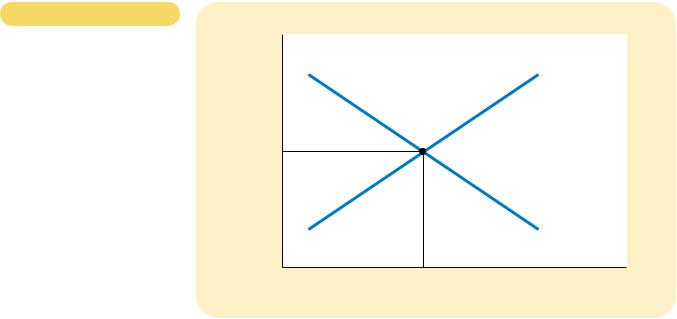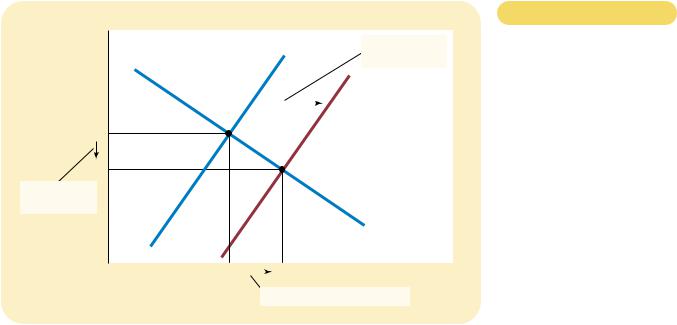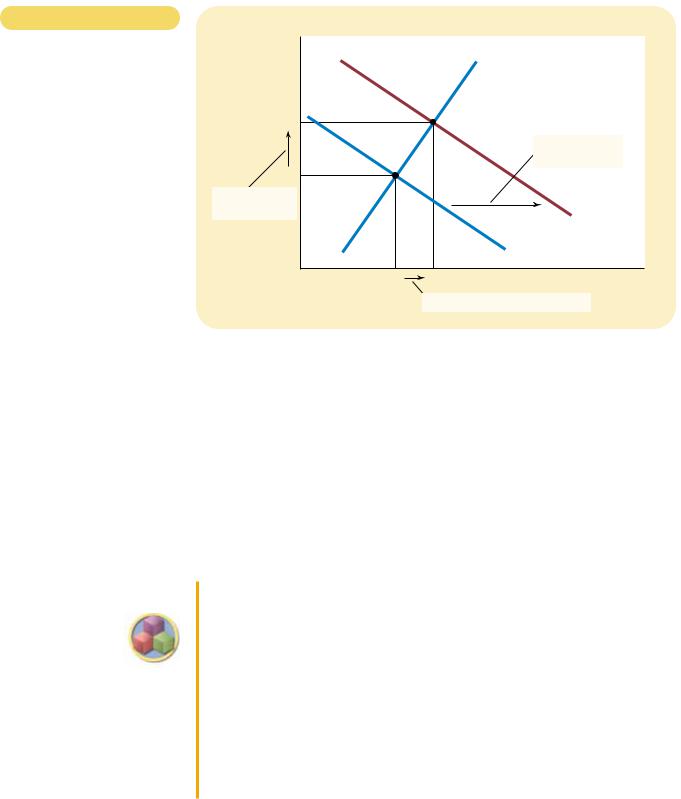
Mankiw Principles of Economics (3rd ed)
.pdf
400 |
PART SIX THE ECONOMICS OF LABOR MARKETS |
|
|
|
|
|
VALUE OF THE |
|
|
|
|
|
|
|
|
MARGINAL PRODUCT |
MARGINAL PRODUCT |
|
MARGINAL |
||
|
LABOR |
OUTPUT |
OF LABOR |
OF LABOR |
WAGE |
PROFIT |
|||
|
L |
|
Q |
MPL ∆Q/∆L |
|
|
∆PROFIT |
||
|
(NUMBER OF WORKERS) (BUSHELS PER WEEK) |
(BUSHELS PER WEEK) |
VMPL P MPL |
W |
VMPL W |
||||
0 |
0 |
100 |
$1,000 |
$500 |
$500 |
|
|||
1 |
100 |
|
|||||||
80 |
800 |
500 |
300 |
|
|||||
2 |
180 |
|
|||||||
60 |
600 |
500 |
100 |
|
|||||
3 |
240 |
|
|||||||
40 |
400 |
500 |
100 |
||||||
4 |
280 |
||||||||
20 |
200 |
500 |
300 |
||||||
5 |
300 |
||||||||
|
|
|
|
|
|||||
|
|
|
HOW THE COMPETITIVE FIRM DECIDES HOW MUCH LABOR TO HIRE |
|
|
||||
|
Table 18-1 |
|
|
||||||
|
|
|
|
|
|
|
|
||
|
|
|
apples minus the total cost of producing them. The firm’s supply of apples and its |
||||||
|
|
|
|||||||
|
|
|
demand for workers are derived from its primary goal of maximizing profit. |
||||||
|
|
|
THE PRODUCTION FUNCTION AND THE |
|
|
|
|||
|
|
|
MARGINAL PRODUCT OF LABOR |
|
|
|
|||
|
|
|
To make its hiring decision, the firm must consider how the size of its workforce |
||||||
|
|
|
affects the amount of output produced. In other words, it must consider how the |
||||||
|
|
|
number of apple pickers affects the quantity of apples it can harvest and sell. Ta- |
||||||
|
|
|
ble 18-1 gives a numerical example. In the first column is the number of workers. |
||||||
|
|
|
In the second column is the quantity of apples the workers harvest each week. |
||||||
|
|
|
These two columns of numbers describe the firm’s ability to produce. As we |
||||||
production function |
|
noted in Chapter 13, economists use the term production function to describe the |
|||||||
the relationship between the quantity |
|
relationship between the quantity of the inputs used in production and the quan- |
|||||||
of inputs used to make a good and |
|
tity of output from production. Here the “input” is the apple pickers and the “out- |
|||||||
the quantity of output of that good |
|
put” is the apples. The other inputs—the trees themselves, the land, the firm’s |
|||||||
|
|
|
trucks and tractors, and so on—are held fixed for now. This firm’s production |
||||||
|
|
|
function shows that if the firm hires 1 worker, that worker will pick 100 bushels |
||||||
|
|
|
of apples per week. If the firm hires 2 workers, the two workers together will pick |
||||||
|
|
|
180 bushels per week, and so on. |
|
|
|
|
||
|
|
|
Figure 18-2 graphs the data on labor and output presented in Table 18-1. The |
||||||
|
|
|
number of workers is on the horizontal axis, and the amount of output is on the |
||||||
|
|
|
vertical axis. This figure illustrates the production function. |
|
|
||||
|
|
|
One of the Ten Principles of Economics introduced in Chapter 1 is that rational |
||||||
|
|
|
people think at the margin. This idea is the key to understanding how firms decide |
||||||
|
|
|
what quantity of labor to hire. To take a step toward this decision, the third column |
||||||
mar ginal product |
|
in Table 18-1 gives the marginal product of labor, the increase in the amount of |
|||||||
of labor |
|
output from an additional unit of labor. When the firm increases the number of |
|||||||
the increase in the amount of output |
|
workers from 1 to 2, for example, the amount of apples produced rises from 100 to |
|||||||
from an additional unit of labor |
|
180 bushels. Therefore, the marginal product of the second worker is 80 bushels. |
|||||||
|
|
|
|
|
|
|
|
|
|
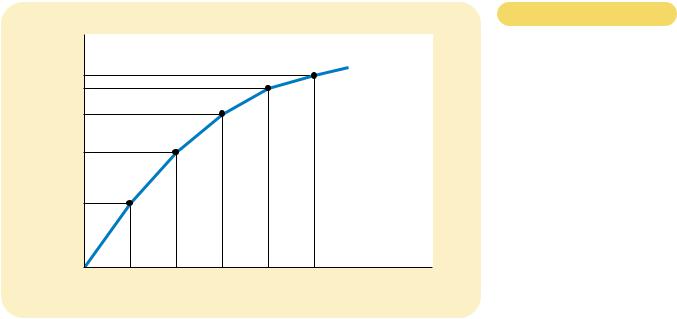
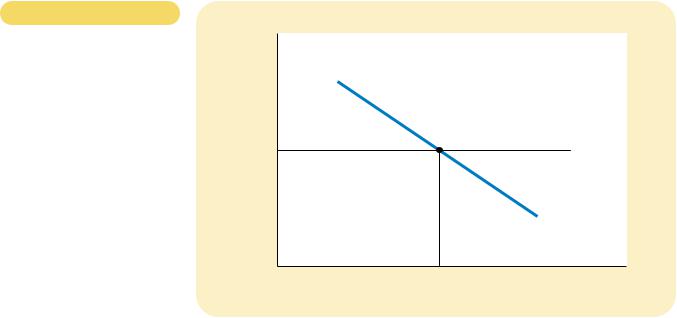

|
CHAPTER 18 THE MARKETS FOR THE FACTORS OF PRODUCTION |
403 |
|
|
|
|
|
F Y I |
|
|
|
Input Demand |
In Chapter 14 we saw how |
worker adds less to the production of apples (MPL falls). |
|
and Output |
a competitive, profit-maximizing |
Similarly, when the apple firm is producing a large quantity |
|
Supply: Two |
firm decides how much of its |
of apples, the orchard is already crowded with workers, so it |
|
Sides of the |
output to sell: It chooses the |
is more costly to produce an additional bushel of apples |
|
Same Coin |
quantity of output at which the |
(MC rises). |
|
|
price of the good equals the |
Now consider our criterion for profit maximization. We |
|
|
marginal cost of production. We |
determined earlier that a profit-maximizing firm chooses the |
|
|
have just seen how such a firm |
quantity of labor so that the value of the marginal product |
|
|
decides how much labor to |
(P MPL) equals the wage (W). We can write this mathe- |
|
|
hire: It chooses the quantity of |
matically as |
|
|
labor at which the wage equals |
|
|
|
the value of the marginal prod- |
P MPL W. |
|
|
uct. Because the production |
If we divide both sides of this equation by MPL, we obtain |
|
function links the quantity of inputs to the quantity of output, |
|
||
you should not be surprised to learn that the firm’s decision |
|
|
|
about input demand is closely linked to its decision about |
P W/MPL. |
|
|
output supply. In fact, these two decisions are two sides of |
|
|
|
the same coin. |
|
We just noted that W/MPL equals marginal cost MC. There- |
|
To see this relationship more fully, let’s consider how |
fore, we can substitute to obtain |
|
|
the marginal product of labor (MPL) and marginal cost (MC) |
|
|
|
are related. Suppose an additional worker costs $500 and |
P MC. |
|
|
has a marginal product of 50 bushels of apples. In this |
|
|
|
case, producing 50 more bushels costs $500; the marginal |
This equation states that the price of the firm’s output is |
||
cost of a bushel is $500/50, or $10. More generally, if W |
equal to the marginal cost of producing a unit of output. |
||
is the wage, and an extra unit of labor produces MPL units |
Thus, when a competitive firm hires labor up to the point at |
||
of output, then the marginal cost of a unit of output is |
which the value of the marginal product equals the wage, it |
||
MC W/MPL. |
|
also produces up to the point at which the price equals mar- |
|
This analysis shows that diminishing marginal product |
ginal cost. Our analysis of labor demand in this chapter is |
||
is closely related to increasing marginal cost. When our ap- |
just another way of looking at the production decision we |
||
ple orchard grows crowded with workers, each additional |
first saw in Chapter 14. |
|
|
|
|
|
|
WHAT CAUSES THE LABOR DEMAND CURVE TO SHIFT?
We now understand the labor demand curve: It is nothing more than a reflection of the value of marginal product of labor. With this insight in mind, let’s consider a few of the things that might cause the labor demand curve to shift.
The Output Price The value of the marginal product is marginal product times the price of the firm’s output. Thus, when the output price changes, the value of the marginal product changes, and the labor demand curve shifts. An increase in the price of apples, for instance, raises the value of the marginal product of each worker that picks apples and, therefore, increases labor demand from the firms that supply apples. Conversely, a decrease in the price of apples reduces the value of the marginal product and decreases labor demand.
Technological Change Between 1968 and 1998, the amount of output a typical U.S. worker produced in an hour rose by 57 percent. Why? The most
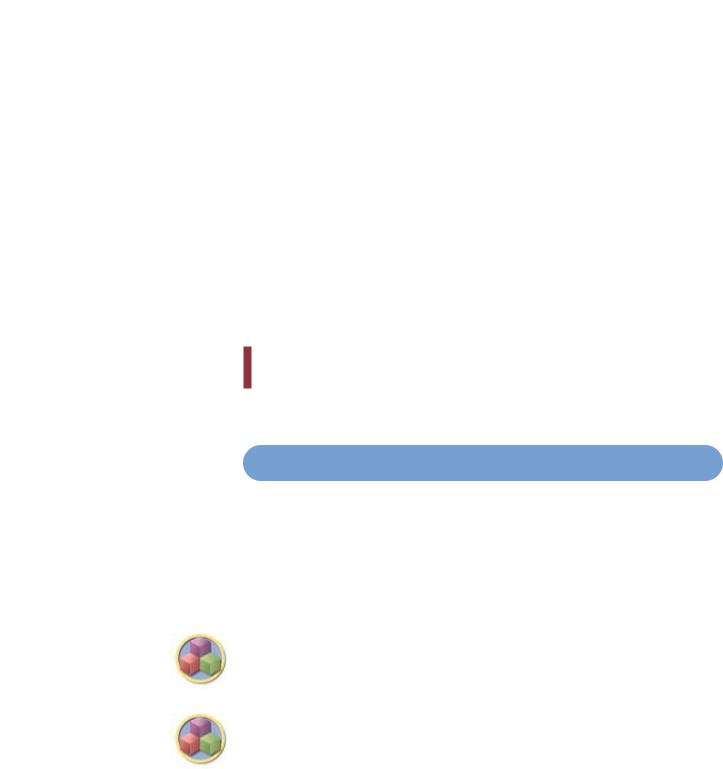
404 |
PART SIX THE ECONOMICS OF LABOR MARKETS |
important reason is technological progress: Scientists and engineers are constantly figuring out new and better ways of doing things. This has profound implications for the labor market. Technological advance raises the marginal product of labor, which in turn increases the demand for labor. Such technological advance explains persistently rising employment in face of rising wages: Even though wages (adjusted for inflation) increased by 62 percent over these three decades, firms nonetheless increased by 72 percent the number of workers they employed.
The Supply of Other Factors The quantity available of one factor of production can affect the marginal product of other factors. A fall in the supply of ladders, for instance, will reduce the marginal product of apple pickers and thus the demand for apple pickers. We consider this linkage among the factors of production more fully later in the chapter.
QUICK QUIZ: Define marginal product of labor and value of the marginal product of labor. Describe how a competitive, profit-maximizing firm decides how many workers to hire.
THE SUPPLY OF LABOR
Having analyzed labor demand in detail, let’s turn to the other side of the market and consider labor supply. A formal model of labor supply is included in Chapter 21, where we develop the theory of household decisionmaking. Here we discuss briefly and informally the decisions that lie behind the labor supply curve.
THE TRADEOFF BETWEEN WORK AND LEISURE
One of the Ten Principles of Economics in Chapter 1 is that people face tradeoffs. Probably no tradeoff is more obvious or more important in a person’s life than the tradeoff between work and leisure. The more hours you spend working, the fewer hours you have to watch TV, have dinner with friends, or pursue your favorite hobby. The tradeoff between labor and leisure lies behind the labor supply curve.
Another one of the Ten Principles of Economics is that the cost of something is what you give up to get it. What do you give up to get an hour of leisure? You give up an hour of work, which in turn means an hour of wages. Thus, if your wage is $15 per hour, the opportunity cost of an hour of leisure is $15. And when you get a raise to $20 per hour, the opportunity cost of enjoying leisure goes up.
The labor supply curve reflects how workers’ decisions about the labor–leisure tradeoff respond to a change in that opportunity cost. An upward-sloping labor supply curve means that an increase in the wage induces workers to increase the quantity of labor they supply. Because time is limited, more hours of work means that workers are enjoying less leisure. That is, workers respond to the increase in the opportunity cost of leisure by taking less of it.
It is worth noting that the labor supply curve need not be upward sloping. Imagine you got that raise from $15 to $20 per hour. The opportunity cost of

CHAPTER 18 THE MARKETS FOR THE FACTORS OF PRODUCTION |
405 |
leisure is now greater, but you are also richer than you were before. You might decide that with your extra wealth you can now afford to enjoy more leisure; in this case, your labor supply curve would slope backwards. In Chapter 21, we discuss this possibility in terms of conflicting effects on your labor-supply decision (called income and substitution effects). For now, we ignore the possibility of backward-sloping labor supply and assume that the labor supply curve is upward sloping.
WHAT CAUSES THE LABOR SUPPLY CURVE TO SHIFT?
The labor supply curve shifts whenever people change the amount they want to work at a given wage. Let’s now consider some of the events that might cause such a shift.
Changes in Tastes In 1950, 34 percent of women were employed at paid jobs or looking for work. In 1998, the number had risen to 60 percent. There are, of course, many explanations for this development, but one of them is changing tastes, or attitudes toward work. A generation or two ago, it was the norm for women to stay at home while raising children. Today, family sizes are smaller, and more mothers choose to work. The result is an increase in the supply of labor.
Changes in Alternative Oppor tunities The supply of labor in any one labor market depends on the opportunities available in other labor markets. If the wage earned by pear pickers suddenly rises, some apple pickers may choose to switch occupations. The supply of labor in the market for apple pickers falls.
Immigration Movements of workers from region to region, or country to country, is an obvious and often important source of shifts in labor supply. When immigrants come to the United States, for instance, the supply of labor in the United States increases and the supply of labor in the immigrants’ home countries contracts. In fact, much of the policy debate about immigration centers on its effect on labor supply and, thereby, equilibrium in the labor market.
QUICK QUIZ: Who has a greater opportunity cost of enjoying leisure—a janitor or a brain surgeon? Explain. Can this help explain why doctors work such long hours?
EQUILIBRIUM IN THE LABOR MARKET
So far we have established two facts about how wages are determined in competitive labor markets:
The wage adjusts to balance the supply and demand for labor.
The wage equals the value of the marginal product of labor.
